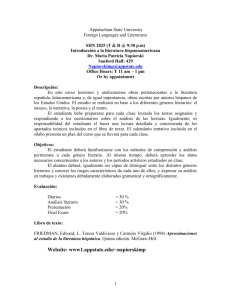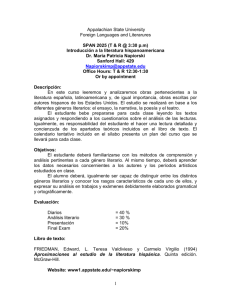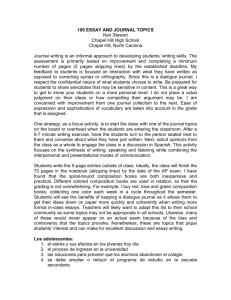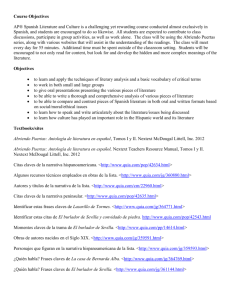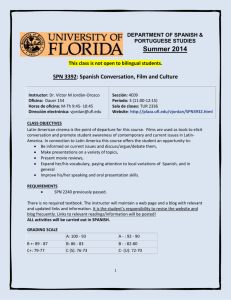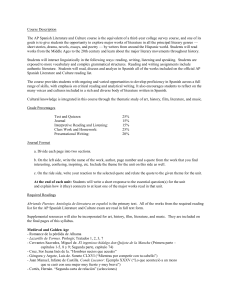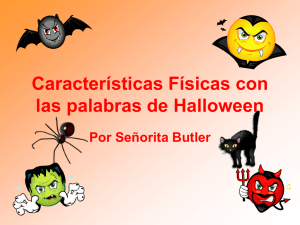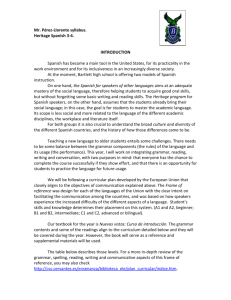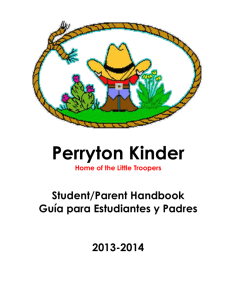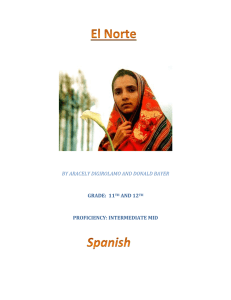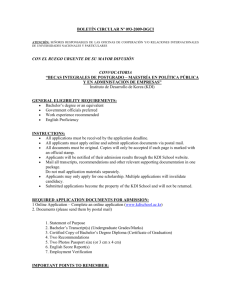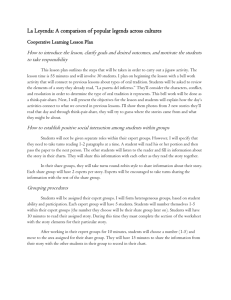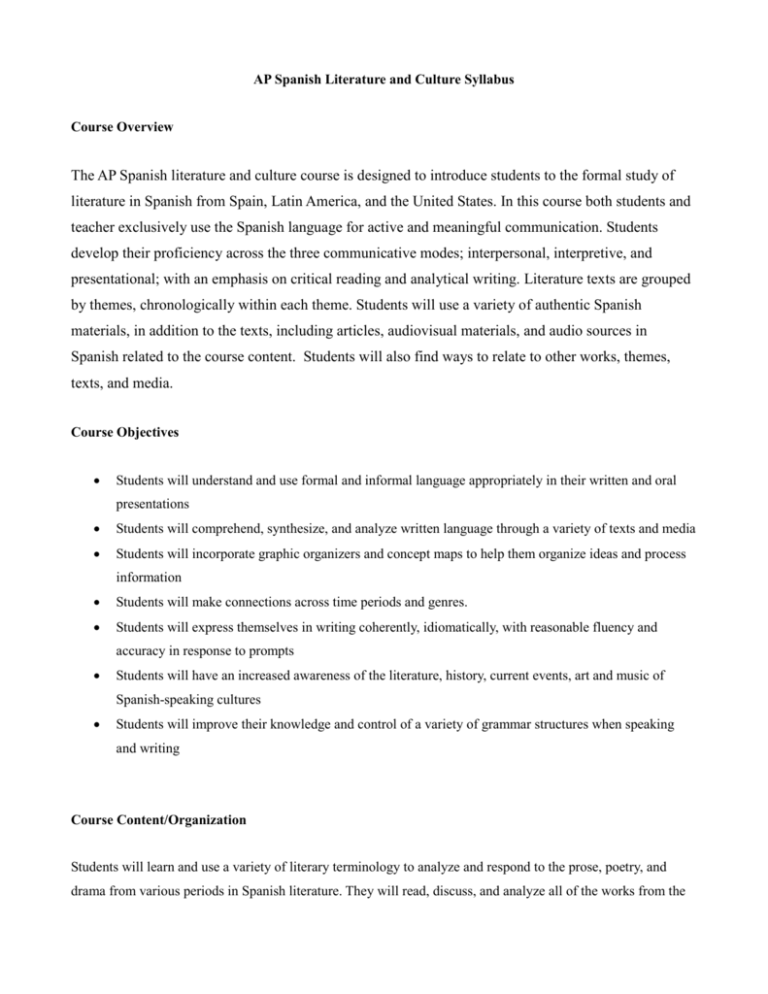
AP Spanish Literature and Culture Syllabus
Course Overview
The AP Spanish literature and culture course is designed to introduce students to the formal study of
literature in Spanish from Spain, Latin America, and the United States. In this course both students and
teacher exclusively use the Spanish language for active and meaningful communication. Students
develop their proficiency across the three communicative modes; interpersonal, interpretive, and
presentational; with an emphasis on critical reading and analytical writing. Literature texts are grouped
by themes, chronologically within each theme. Students will use a variety of authentic Spanish
materials, in addition to the texts, including articles, audiovisual materials, and audio sources in
Spanish related to the course content. Students will also find ways to relate to other works, themes,
texts, and media.
Course Objectives
•
Students will understand and use formal and informal language appropriately in their written and oral
presentations
•
Students will comprehend, synthesize, and analyze written language through a variety of texts and media
•
Students will incorporate graphic organizers and concept maps to help them organize ideas and process
information
•
Students will make connections across time periods and genres.
•
Students will express themselves in writing coherently, idiomatically, with reasonable fluency and
accuracy in response to prompts
•
Students will have an increased awareness of the literature, history, current events, art and music of
Spanish-speaking cultures
•
Students will improve their knowledge and control of a variety of grammar structures when speaking
and writing
Course Content/Organization
Students will learn and use a variety of literary terminology to analyze and respond to the prose, poetry, and
drama from various periods in Spanish literature. They will read, discuss, and analyze all of the works from the
required AP reading list in Spanish.
The course addresses each of the following themes in detail:
1. Las sociedades en contacto
2. La construcción del género
3. El tiempo y el espacio
4. Las relaciones interpersonales
5. La dualidad de ser
6. La creación literaria
AP Required Reading List
1.Allende, Isabel, “Dos palabras”
2.Anónimo, “Romance de la pérdida de Alhama”
3.Anónimo, Lazarillo de Tormes (Prólogo; Tratados 1, 2, 3, 7)
4.Bécquer, Gustavo Adolfo, Rima LIII (“Volverán las oscuras golondrinas”)
5.Borges, Jorge Luis,“Borges y yo”
6.Borges, Jorge Luis, “El Sur”
7.Burgos, Julia,“A Julia de Burgos”
8.Cervantes, Miguel de, Don Quijote (Parte I, capítulos 1-5, 8 y 9; Parte II, capítulo 74)
9.Cortázar, Julio, “la noche boca arriba”
10.Cortés, Hernán,“Segunda carta de relación” (selecciones)
11.Cruz, Sor Juana Inés de la, “Hombres necios que acusáis”
12.Darío, Rubén,“A Roosevelt”
13.Don Juan Manuel, El Conde Lucanor. “Exemplo XXXV” “De lo que aconteció a un mozo
casó con una mujer muy fuerte y muy brava”
14.Dragún, Osvaldo, El hombre que se convirtió en perro
15.Fuentes, Carlos, “Chac Mool”
16.García Lorca, Federico, La casa de Bernarda Alba
17.García Lorca, Federico, “Prendimiento de Antoñito el Camborio en el camino de Sevilla”
18.García Márquez, Gabriel, “El ahogado más hermoso del mundo”
19.García Márquez, Gabriel, “La siesta del martes”
20.Garcilaso de la Vega, Soneto XXIII “En tanto que de rosa y azucena”
21.Góngora y Argote, Luis de, Soneto CLXVI “Mientras por competir con tu cabello”
22.Guillén, Nicolás,“Balada de los dos abuelos”
23.Heredia, José María, “En una tempestad”
que
24.León-Portilla, Miguel, Visión de los vencidos (dos secciones: “Los presagios, según los informantes
de Sahagún” y “Se ha perdido el pueblo mexicatl”)
25.Machado, Antonio,“He andado muchos caminos”
26.Martí, José, “Nuestra América”
27.Montero, Rosa, “Como la vida misma”
28.Morejón, Nancy, “Mujer negra”
29.Neruda, Pablo, “Walking around”
30.Pardo Bazán, Emilia,“Las medias rojas”
31.Quevedo, Francisco de, Salmo XVII “Miré los muros de la patria mía”
32.Quiroga, Horacio, “El hijo”
33.Rivera, Tomás, …y no se lo tragó la tierra (dos capítulos: “…y no se lo tragó la tierra” y “La noche
buena”)
34.Rulfo, Juan, “No oyes ladrar los perros”
35.Storni, Alfonsina, “ Peso ancestral”
36.Tirso de Molina, El burlador de Sevilla y convidado de piedra
37.Ulibarrí, Sabine, “Mi caballo mago”
38.Unamuno, Miguel de, San Manuel Bueno, martir
Themes
#1. Las sociedades en contacto
Essential Questions:
• ¿De qué manera las perspectivas de una cultura afectan la representación de eventos
históricos?
• ¿Cómo los miembros de una minoría cultural se resisten (o se asimilan) a las costumbres y las
perspectivas de la mayoría dominante?
• ¿Cómo se representan en obras literarias de distintos períodos y diversas culturas las
relaciones entre
grupos socioculturales (clases sociales, grupos étnicos, etc.)?
Works:
•
Anónimo, “Romance de la pérdida de Alhama” siglo XV
•
León-Portilla, Miguel, Visión de los vencidos “Los presagios, según los informantes de Sahagún” documentos antes de la llegada de los espanoles a Tenochtitlán
•
Cortés, Hernán “Segunda carta de relación” (selecciones) 1520
•
León-Portilla, Miguel, Visión de los vencidos “Se ha perdido el pueblo mexicatl” - documentos
despues de la llegada de los espanoles a Tenochtitlán
•
Anónimo, Lazarillo de Tormes (Prólogo; Tratados 1, 2, 3, 7) 1554
•
Martí, José, “Nuestra América” 1891
•
Darío, Rubén, “A Roosevelt” 1905
•
García Lorca, Federico, “Prendimiento de Antoñito el Camborio en el camino de Sevilla” 1928
•
Dragún, Osvaldo, El hombre que se convirtió en perro 1956
•
Rivera, Tomás,…y no se lo tragó la tierra (dos capítulos “… y no se lo tragó la tierra” y “La noche
buena”) 1971
Ejemplos de actividades:
1. “Las sociedades en contacto” will be introduced by discussing Francisco de Goya’s paintings
El dos de mayo de 1808 en Madrid, Los fusilamientos del tres de mayo -1814 and Coloso 1808-1810.
Students will then discuss advantages and disadvantages that occur when societies come in contact with
each other.
Before beginning “Romance de la pérdida de Alhama”, students will see and discuss personal photos and
books from Granada and the Alhambra.
2. Lazarillo de Tormes - The students will write an essay, analyzing how the theme is expressed
in the work. Students will also do research on La sociedad española del siglo XVI and take notes on
how this historical period relates to the social culture in El Lazarillo for an oral presentation.
3. Cortés, “Segunda carta de relación.” Working in pairs students will write three paragraphs
centering on the comparisons which Cortés makes between what he has seen in Spain and what he
finds in the new city he has just entered.
4. Darío, “A Roosevelt.” Students will be divided into small groups, with each group assigned
several lines from the text with the goal of pointing out to the other students differences indicated by
Darío between the United States and Spanish America.
5. After studying Martí’s and Darío’s works, students will compare their messages to the lyrics
of the song “América” by Spain’s José Luis Perales (fuente: musica.com/ letras). Students will then
write their own version (essay, poem or song) of how they envision Hispanoamérica.
#2. La construcción del género
Essential Questions:
• ¿Cómo revela la literatura los cambios en la percepción de los géneros masculino y femenino?
• ¿De qué manera han servido los factores socioculturales como instrumentos de cambios (o no) en la
representación de los géneros?
• ¿Cómo ha cambiado la representación de lo femenino (voces femeninas, personajes
femeninos) a lo
largo de la historia de la literatura?
Works:
• Don Juan Manuel, El Conde Lucanor, “De lo que aconteció a un mozo que casó con una
mujer muy fuerte y muy brava” siglo XI
•
Tirso de Molina, El burlador de Sevilla y convidado de piedra 1630
•
Cruz, Sor Juana Inés de la, “Hombres necios que acusáis” fines del siglo XVII
•
Storni, Alfonsina, “ Peso ancestral” 1919
•
Morejón, Nancy, “Mujer negra” 1944
•
Allende, Isabel, “Dos palabras” 1989
Ejemplos de actividades:
“La construcción del género” will be introduced with a class discussion that will revolve around the
question: What is the general attitude on women?
1. Storni’s poem will be introduced and read. Students will then listen to Pedro Fernández sing:
“Dicen que los hombres no deben llorar.” After this, students will create a graphic organizer to discuss
gender stereotypes.
2. Students will analyze how “La construcción del género” is depicted in Sor Juana’s and Storni’s poems
and write an essay comparing these two perceptions.
3. Morejón, “Mujer negra” Students will discuss how males are depicted in this work versus how
females are depicted and compare these depictions with those found in the story by don Juan Manuel Conde
Lucanor: Ejemplo XXXV (“Lo que aconteció a un mozo que se casó con una mujer muy fuerte y muy brava”).
4. Students will also research Don Juan’s character in world literature and music: Molière’s play Don
Juan ou le Festin de Pierre (1665), Byron’s epic poem Don Juan (1821), José de Espronceda’s poem “El
estudiante de Salamanca” (1840), José Zorrilla’s play Don Juan Tenorio (1844) and Don Giovanni, the opera
composed by Wolfgang Amadeus Mozart (1787). Additionally, students will write an essay comparing and
contrasting the ending in Tirso’s and Zorrilla’s plays.
5. After reading Sor Juana’s redondillas, students will compare them to the lyrics of “Dime que no” by
Guatemala’s Ricardo Arjona (fuente: musica.com/letras). Group discussion will follow.
#3. El tiempo y el espacio
Essential Questions:
• ¿Cómo presentan las literaturas de distintas culturas los conceptos del tiempo y el espacio?
• ¿De qué manera los autores se valen del tiempo y el espacio para construir una variedad de
estados
de ánimos o sentimientos (p. ej. la desorientación, la nostalgia, el remordimiento)?
• ¿Cómo se relacionan la representación del espacio y el manejo del tiempo en una obra literaria?
Works:
•
Garcilaso de la Vega, Soneto XXIII “En tanto que de rosa y azucena” 1543
• Góngora y Argote, Luis de, Soneto CLXVI “Mientras por competir con tu cabello” 1612
• Quevedo, Francisco de, Salmo XVII “Miré los muros de la patria mía” 1613
• Heredia, José María, “En una tempestad” 1820 o 1824
• Machado, Antonio, “He andado muchos caminos” 1903
• Neruda, Pablo, “Walking around” 1935
• Fuentes, Carlos, “Chac Mool” 1954
Ejemplos de actividades:
1. The theme will be introduced by studying the painting La persistencia de la memoria by
Salvador Dalí, and definitions of time and space will be presented and discussed; a brief presentation of
the findings is required.
Students will then identify similarities and differences between the depiction of time and space in this
work with the depiction of the same concepts in the poem “Walking around” by Neruda, and discuss
why the poetic voice feels so disconnected with his environment and his negative reactions to the world
which he inhabits and how these perceptions are made more vivid through the use of rhetorical devices.
2. Students will research the meaning of carpe diem and discuss how it is exemplified in Góngora’s
“Mientras por competir con tu cabello.”
3. Sandro Boticelli´s painting, The Birth of Venus will be presented. Students will write a paragraph
comparing the symbolisms of the woman in the painting to those described in Garcilaso’s and Góngora’s poems.
4. Joan Manuel Serrat’s song “Benito” from his album Nadie es perfecto (1994) will be heard as
lyrics are read in order to compare the poetic devices to Machado’s text. A graphic organizer will be
used in order to facilitate the analysis of Machado’s devices.
#4. Las relaciones interpersonales
Essential Questions:
• ¿De qué manera se transforma el/la protagonista de una obra a consecuencia de sus relaciones con
otros personajes?
• ¿De qué manera los individuos contribuyen o perjudican al bienestar de la familia o la comunidad?
• ¿Cómo influye el contexto sociocultural en el desarrollo de las relaciones interpersonales?
Works:
•
Bécquer, Gustavo Adolfo, Rima LIII “Volverán las oscuras golondrinas” 1871
• Pardo Bazán, Emilia,“Las medias rojas” 1914
• Quiroga, Horacio, “El hijo” 1928
• García Lorca, Federico, La casa de Bernarda Alba 1936
• Rulfo, Juan, “No oyes ladrar los perros” 1953
• García Márquez, Gabriel, “La siesta del martes” 1962
• Ulibarrí, Sabine, “Mi caballo mago” 1964
• Montero, Rosa, “Como la vida misma” 1982
Ejemplos de actividades:
1. Scenes from the Spanish film, La Casa de Bernarda Alba will be shown and the students will
contrast “Las relaciones familiares” as depicted in this play with those revealed in Rulfo’s “No oyes
ladrar los perros.” Students will then list a minimum of ten symbols which appear in the play and
working in pairs specify in written paragraphs how these symbols reflect the social, cultural and
historical context of the “pueblos de España” where the work takes place. Students will then discuss
why La casa de Bernarda Alba is a drama and not a tragedy.
2. Quiroga, “El hijo” Students will discuss how cultural perspectives influence the attitude and
behavior of the father.
3. Rulfo, “No oyes ladras los perros”. Students will write an essay in which they discuss the
relationship between the father and the son and explain how the point of view of the narrator influences
the reader’s perception of this relationship.
4. Bécquer, Rima LIII (“Volverán las oscuras golondrinas”). Students will discuss the parallel
constructions found in each strophe of the poem and identify how these parallelisms relate to past and
present situations and feelings as they are depicted in the work. Students will also listen to “Jueves” by
Oreja de Van Gogh and discuss how the reference to Becquer’s poem is used.
5. Pardo Bazán, “Las medias rojas” Students will discuss the roles taken by Ildara with those
carried out by her father with the goal of determining why he reacts the way he does and debating the
issue of whether he is a responsible parent or not.
6. After analyzing “Las medias rojas”, students will read the lyrics of the 2005 song “Malo” by
Spanish artist Bebe in order to write a short comparative essay analyzing “las relaciones personales”.
#5. La dualidad de ser
Essential Questions:
• ¿Qué preguntas plantea la literatura acerca de la realidad y la fantasía?
• ¿Cómo influye el contexto sociocultural o histórico en la expresión de la identidad?
• ¿Cuál es el significado de la vida (para un personaje, para un autor) y cómo se relaciona esto
con las
creencias o ideas en cuanto a la muerte?
Works:
•
Guillén, Nicolás, “Balada de los dos abuelos” 1934
• Burgos, Julia, “A Julia de Burgos” 1938
• Borges, Jorge Luis, “El Sur” 1956
• Borges, Jorge Luis, “Borges y yo” 1957
• Cortázar, Julio “La noche boca arriba” 1956
• García Márquez, Gabriel, “El ahogado más hermoso del mundo” 1968
Ejemplos de actividades:
“La dualidad del ser” will be introduced by studying Xul Solar’s 1919 painting Cara. Students will
define and discuss how artistic symbolism functions in the creation of art and literature.
1. After reading and analyzing “A Julia de Burgos” by Julia de Burgos, students will study Frida
Kahlo’s painting, Las dos Fridas. A graphic organizer will be used to compare and contrast the theme
of identity in both works.
2. Borges, “Borges y yo” Students will determine the identity of the two individuals described
in this essay and relate it to the concept of dual/ multiple identities in their own lives.
#6. La creación literaria
Essential Questions:
• ¿Qué factores motivan a los escritores a crear sus obras literarias?
• ¿De qué manera la intertextualidad contribuye al significado de una obra literaria?
• ¿Cómo influye en la experiencia de los lectores la presencia de la literatura misma como tema de una
obra literaria?
Works:
•
Cervantes, Miguel de, Don Quijote (Primera parte, capítulos 1-5, 8 y 9; Segunda parte, capítulo 74) 1605
• Unamuno, Miguel de, San Manuel Bueno, mártir 1933
Ejemplos de actividades:
“La creación literaria” will be introduced by watching scenes from the production of “Don Quixote”
with the Ballet Nacional de Cuba (2007). The creative process of this artistic adaptation will be
discussed.
1. Don Quijote, Don Quijote. Students will write an essay in which they discuss how this text
reflects the historical and socio-political contexts in which it was written. Students will then write a
short response to the question:What is Don Quijote’s significance in your own experience?
2. Unamuno, San Manuel Bueno, mártir. Students will write an essay in which they contrast the
public and the private images of the main character. They will then discuss the internal structure of the
work as they talk about the título, epígrafe, exposición, enlace, punto decisivo, punto cumbre,
desenlace, and epílogo.
3. Students will write a brief text (prose or poetry) inspired by any of the texts studied in class.
A short composition supporting the creative process will be included as part of the project to be shared.
Activities/Summative Activities
•
student portfolios with outlines for each work studied, including; title, author, genre, plot, characters,
main ideas, dates, essential questions, and locations
•
graphic organizers and concept maps for processing information and organizing ideas
•
student journals with quotes from selected works and reactions in Spanish
•
essays analyzing/comparing/contrasting how themes are expressed throughout various works
•
paragraphs written in pairs of students, focusing on comparisons within works and between texts
•
group work-assigning different parts of a text, pointing out similarities and differences between works,
countries, opinions, gender, etc.
•
jigsaw reading in small groups
•
mini art lessons on various Hispanic artists and their works (Dali's “Persistence of Memory”, Kahlo's
“Las Dos Fridas”, Rivera's histories of Mexico, Goya's “dos de mayo”, “tres de mayo”)
•
various texts to add to the works (books of paintings by the artists, comic book version of Don Quixote,
books from and about Sevilla and La Alhambra)
•
scenes from movies related to the works (La Casa de Bernarda Alba, Don Quixote)
•
music that contributes to the literature (La Oreja de Van Gogh's “Jueves”, Bebe's “Malo”, Ricardo
Arjona's “Dime Que No”, Belinda's “Carpe Diem”)
Texts and Resources
•
•
•
•
•
•
•
•
•
•
•
•
•
•
•
•
•
•
•
•
•
•
•
•
•
Bowen y Bowen. Abriendo Puertas. Houghton Mifflin Harcourt, 2013.
Herrera, Carmen and Lamontagne, Paul. A Toda Vela St. Paul, MN.: EMC Publishing, 2008.
Scmitt, Conrad J.Asi se dice Columbus, OH.: Glencoe/McGraw Hill, 2009.
Diaz, Jose M., Nadel, Maria, Collins, Stephen J. Abriendo Paso, Lectura Boston, MA.:
Pearson Prentice Hall, 2007.
Molina, Tirso de. El burlador de Sevilla, Madrid, Spain.: Alianza Editorial, 2011.
Rivera, Tomas. ...y no se lo trago la tierra, Houston, TX.: Pinata Books, 1996.
Anonimo, Lazarillo de Tormes, Burgos, Spain, 2010.
Cervantes, Miguel de. Don Quijote, Newark, DE.: LinguaText, Ltd., 2012.
Renjilian-Burgy, Joy and Valette, Rebecca M. Album, New York, NY.: Houghton Mifflin
Company, 2005.
Friedman, Edward H., Valdivieso, L. Teresa, and Virgillo, Carmelo. Aproximaciones,
McGraw-Hill, Inc., 1994.
Bretz, Dvorak, Kirschner, and Kihyet. Pasajes Literatura, New York, NY.:McGraw-Hill,
2006.
Adey, Margaret and Albini, Louis. Galeria de arte y vida, McGraw-Hill/Glencoe, 2007.
Varona-Lacey, Gladys. Contemporary Latin American Literature, McGraw-Hill, 2001.
http://www.colby.edu/~bknelson/SLC/ojala/index.html
http://www.colby.edu/~bknelson/SLC/index.php
www.thepaperboy.com
www.nacion.com
www.bbcmundo.com
www.cervantesvirtual.com
www.prensaescrita.com/
www.clta.net/lessons/
www.quixote.tv
www.thinkspanish.com
www.nuevoshorizontes.org
www.yabla.com

